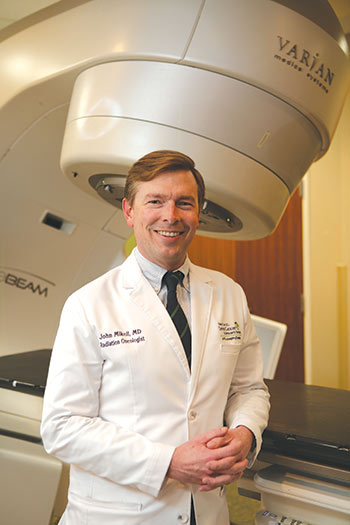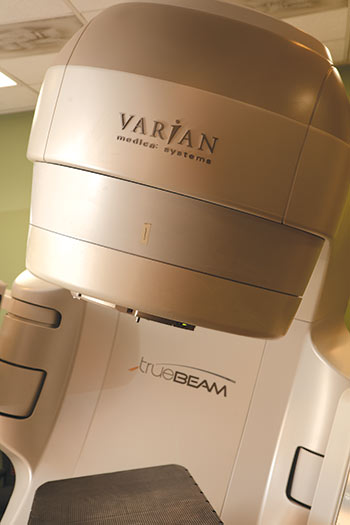Making Headway In Cancer Treatment
How advanced radiation therapy and individualized treatment helps patients with head and neck cancer
Nobody likes to go to the dentist—even dentists themselves have accepted this truth. But here’s a point in their favor: through a simple oral exam, your dentist can help detect head and neck cancers at an earlier stage.
“Regular dental visits will give your provider a chance to look for anything abnormal,” explains radiation oncologist John Mikell, MD.

Oral lesions that could be precursors to cancer can present as white or red patches that don’t resolve in two weeks. Other signs include a thickening in the oral soft tissue, difficulty chewing or numbness of the tongue.
If cancer is found inside the mouth, throat or voice box, treatment can include radiation therapy, chemotherapy, surgery or a combination of therapies.
“There is a big team approach to head and neck cancer,” Dr. Mikell says. “It is often a combined effort between radiation oncology, medical oncology and surgery, but the team also includes dietitians, occupational therapists, and our nurse navigators. It’s a continuous process in a treatment plan that is tailored to each individual patient.”
A Precise Map
The group of cancers known collectively as head and neck cancers are often squamous cell carcinomas. This is because they usually originate in the squamous cells, which are thin, flattened cells within the moist inner lining of the mouth, throat and voice box. The oral cavity that is susceptible to these cancers includes the lips, gums and inner lining of the cheeks.
Not surprisingly, two major risk factors for head and neck cancers are tobacco and alcohol use. But Dr. Mikell and his colleagues have also noticed a new trend: head and neck cancers caused by human papillomavirus, or HPV. Infection with HPV is a major risk factor for oropharyngeal cancer, a type of head and neck cancer that can affect the back of the tongue, the tonsils, the soft palate and the back walls of the throat.
“Patients with HPV-related head and neck cancer tend to have a very good prognosis relative to the more traditional head and neck cancers that are related to smoking and drinking,” Dr. Mikell says.
But no matter the cause, head and neck cancer patients who need radiation therapy will receive highly planned, finely-sculpted treatment at the Lewis Cancer & Research Pavilion (LCRP).
“With advanced technology such as the TrueBeam radiotherapy system, we have the ability to perform image-guided radiation, meaning we can see what we need to do each day, and can plan and map out more precisely where the radiation will go,” Dr. Mikell says.

This capability is crucial to head and neck cancer treatment, where anatomy can change if the patient loses weight or the tumor responds dramatically.
“We can basically re-plan the radiation in the middle of the course, if necessary,” Dr. Mikell says. “This helps us to maximize the patient’s best chance of cure and to minimize the chance of long-term toxicity.”
Moving Forward As A Team
Dr. Mikell concedes that the treatment course for head and neck cancer—typically about seven weeks of treatment—can be difficult.
“We are able to sculpt the dose better than ever before, but treatment can affect sensitive tissues that we often take for granted,” Dr. Mikell says. “Patients may experience altered taste, dry mouth or trouble swallowing.”
This is where team play kicks in at the LCRP — with dietitians meeting regularly with patients to make sure they are getting enough nutrition and with occupational therapists helping patients manage their swallowing before, during and after treatment.
“The glue that holds all this together is our nurse navigation team,” Dr. Mikell says. “They help coordinate appointments between the different specialists and providers. If a patient feels overwhelmed by where they need to be and when, the nurse navigator can help smooth all those questions out.”
Which brings us back to the dentist—Dr. Mikell and the nurse navigators make sure that any dental issues a patient may face are addressed throughout the continuum of care.
“We are proactive about looping the dentist in early on,” he says. “With radiation therapy for head and neck cancers, there can be a risk for dental decay down the road. If the patient needs extractions or anything like that, we can get that done before they start treatment.”
It is all part of tailoring treatment to the patient not only in the planning stages of therapy, but also when the cancer’s response to treatment requires revised plans.
“The ability to react to changes in the patient’s anatomy is a great leap forward,” Dr. Mikell says. “And the capability to do that kind of re-planning is only going to get stronger.”